Balkan countries

Julia Braungart,Studien zur frühkupferzeitlichen Foeni-Gruppe im südwestlichen Rumänien anhand der Gefäßkeramik aus Foeni-Cimitirul OrtodoxCluj – Napoca 2022ISBN 978-606-020-444-2626 S./pp., zahlr. Farb- und S/W-Abb./num colour and b/w-figs., 29,7 x 21 cm; kartoniert/hardcover

Salvator Žitko – Brigitta Mader,Med Benetkami in Dunajem [Zwischen Venedig und Wien]Kulturna dediščina kot predmet nacionalnega prestiža in istrske identiteteKoper – Capodistria 2025ISBN 978-961-6732-71-0252 S./pp., zahlr. Farb- und S/W-Abb./num colour and b/w-figs., 29,7 x 21 cm; kartoniert/hardcover slowenisch (S. 1 - 176) und deutsch (S. 177 - 234) Das Buch „Zwischen Venedig und Wien“ von Salvator Žitek und Brigitte Mader enthüllt eine lange verborgene Geschichte über das Schicksal des kulturellen Erbes Istriens und der Küste während der Evakuierungen in Kriegszeiten und der politischen Umsiedlungen nach dem Krieg und wirft wichtige Fragen zum Denkmalschutz und zur gemeinsamen Verantwortung im heutigen Europa auf. In der Studie „Zwischen Venedig und Wien“, die das Ergebnis ihrer langjährigen Forschung auf dem Gebiet des Kulturerbeschutzes im Gebiet der ehemaligen österreichischen Küste, später der Julischen Alpen und heute insbesondere Istriens mit seinem nahen Hinterland ist, befassen sich die Autoren mit Fragen im Zusammenhang mit der Haltung der jeweiligen Regierungsstrukturen gegenüber beweglichem Kulturgut, aber auch mit den Massenevakuierungen zwischen 1940 und 1944 von wertvollen Kunstwerken, archäologischem Material, Archiven und individuellen Büchersammlungen, insbesondere aus Koper und Piran, die nach 1945 und 1954, als sich die politischen Grenzen änderten, auf italienischem Boden verblieben und Gegenstand zwischenstaatlicher Verhandlungen und Restitutionsforderungen wurden. Aufgrund der noch immer ungelösten Probleme und der unterschiedlichen Ansichten von Fachkreisen beiderseits der ehemaligen Grenze ist die Monographie äußerst aktuell und wichtig für einen umfassenderen Einblick in diese Thematik, auch für die breite Öffentlichkeit und verantwortliche Kreise, da sie zu einer nachdenklichen Reflexion im Kontext gemeinsamer Anstrengungen und der Pflege von Werten im Rahmen der heutigen Europäischen Union anregt.

Biba Teržan,Vače II. Halštatske najdbe v Naravoslovnem muzeju na Dunaju / Hallstattzeitliche Funde im Naturhistorischen Museum Vienna / Hallstatt Period Finds in the Natural History Museum Vienna(Catalogi et Monographiae / Katalogi in monografije 47)Ljubljana 2025ISBN 978-961-6981-81-1ca. 448 S./pp., zahlr. Farb- und S/W-Abb. / num. colour and b/w-figs., 34 x 23,5 cm; kartoniert mit Schutzumschlag / hardcover with dust jacket

Ivan Josipovič – Miljenko Jurkovič (eds.), Aspice hunc opus mirum. Zbornik povodom sedamdesetog rođendana Nikole Jakšića / Festschrift on the occasion of Nikola Jakšic's 70th birthdayZadar – Zagreb – Montovun 2020ISBN 978-953-331-304-7 220 S./pp., 233 Farb- und S/W-Abb./num. colour and b/w-figs., 23,5 x 16,5 cm; broschiert/softcover zweisprachig kroatisch - englischbilingual croatian - english
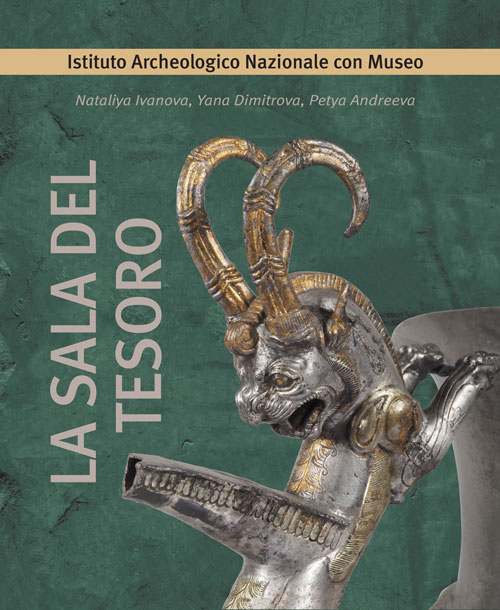
Nataliya Ivanova – Yana Dimitrova – Petya Andreeva, La Sala del Tesoro(National Archaeological Museum. Catalogues. Volume 41) Sofia 2023ISBN 978-619-254-022-7ISSN 2367-8860)84 S./pp., zahlr. Farbabb./num. colour figs., 25 x 21 cm; broschiert/softcover
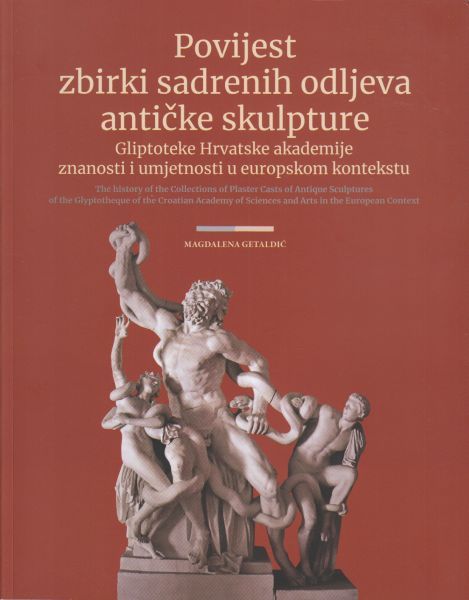
Magdalena Getaldić,Povijest zbirki sadrenih odljeva antičke skulpture Gliptoteke Hrvatske akademije znanosti i umjetnosti u europskom kontekstu / The history of the collections of plaster casts of antique sculptures of the Glyptotheque of the Croatian Academy of Sciences and Arts in the European contextZagreb 2024ISBN 978-953-347-604-9396 S./pp., zahlr. Farb- und S/W-Abb./num. colour and b/w-figs., 27 x 21 cm; broschiert/softcoverzweisprachig kroatisch – englisch / bilingual croatian – englishThis is the first monographic presentation of collections of plaster casts in Croatia, offering a detailed insight into the historical development, importance and role of casts in the history of sculpture – from antiquity to the present day. Through interdisciplinary research and comparative analysis in relation to the most famous European collections, the book examines the significance of plaster casts and their role in understanding ancient sculpture.
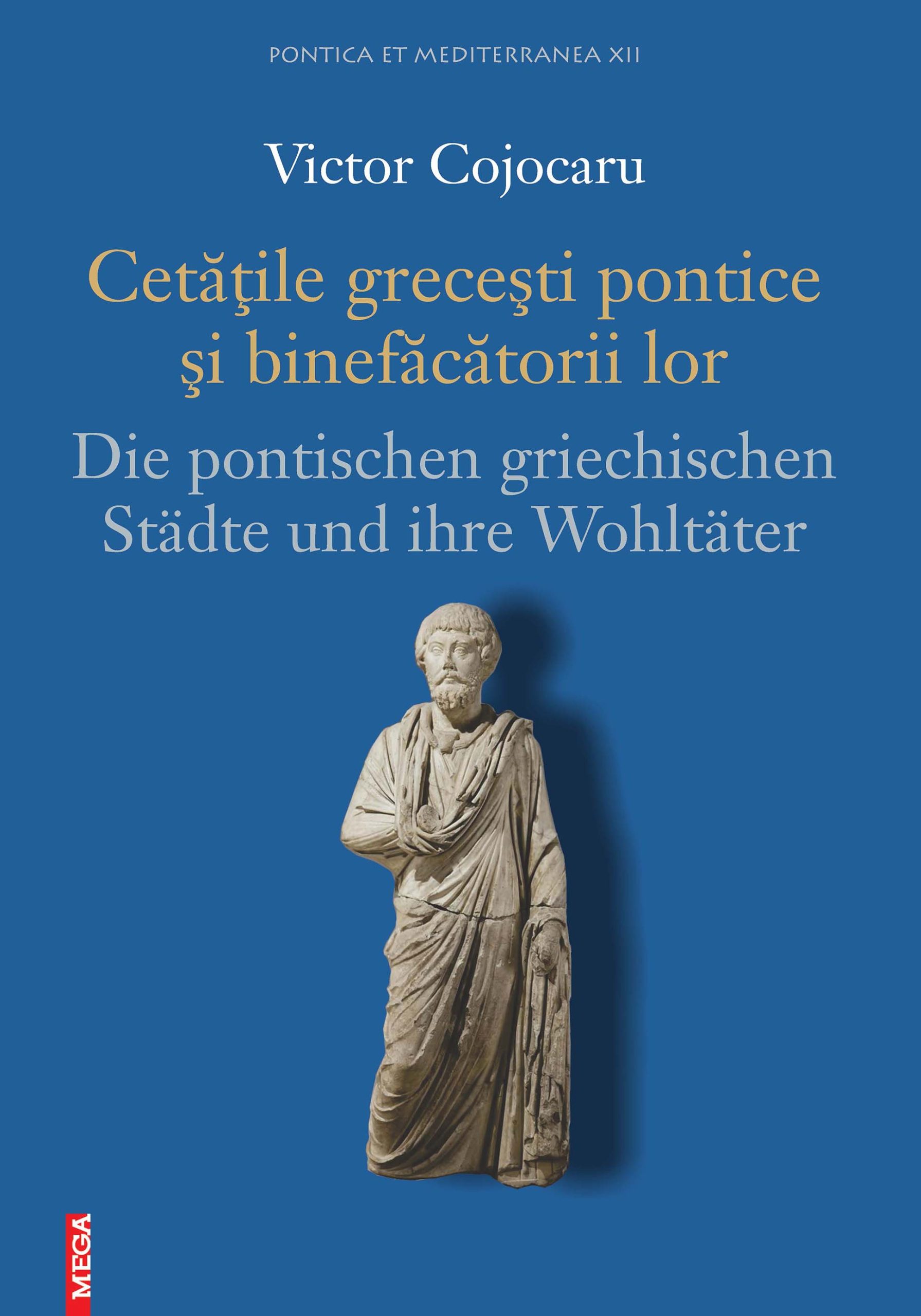
Victor Cojocaru,Cetăţile greceşti pontice şi binefăcătorii lor /Die pontischen griechischen Städte und Ihre Wohltäter(Pontica et Mediterranea, Band XII)Cluj – Napoca 2025ISBN 978-606-020-951-5738 S./pp., zahlr. Farb- und S/W-Abb./num. colour and b/w-figs., 24,5 x 18 cm; kartoniert/hardcoverrumänisch mit ausführlicher deutscher Zusammenfassung /romanian with extended german summaryDas Buch ist eine Weiterführung der Forschungen des Autors zur Institution der Proxenie im Schwarzmeerraum und weitet den Blick auf die Frage nach der Rolle von Wohltätern im Leben pontischer griechischer Städte. Gestützt auf eine umfassende epigraphische Dokumentation und einen konsequent angewendeten vergleichenden Ansatz, wirft der Band ein neues Licht darauf, wie wohltätige Handlungen – und deren öffentliche Ehrung – den sozialen Zusammenhalt und die Stabilität dieser antiken Gemeinschaften förderten. Das Werk richtet sich gleichermaßen an Fachleute wie an ein breiteres Publikum, das sich für die Ursprünge des europäischen Bürgersinns interessiert. Es bietet eine tiefgehende Reflexion über gemeinnütziges Engagement in der Antike und unterstreicht dessen anhaltende Bedeutung für heutige Debatten um gesellschaftliche Verantwortung.

Nenad Cambi, Triptych of Studies. Essays of Ancient Sculptures / Triptih Studija: Eseji o antičkoj skulpturiSplit 2025ISBN 978-953-163-567-7 220 S./pp., 233 Farb- und S/W-Abb./num. colour and b/w-figs., 23,5 x 16,5 cm; broschiert/softcover zweisprachig kroatisch - englischbilingual croatian - english
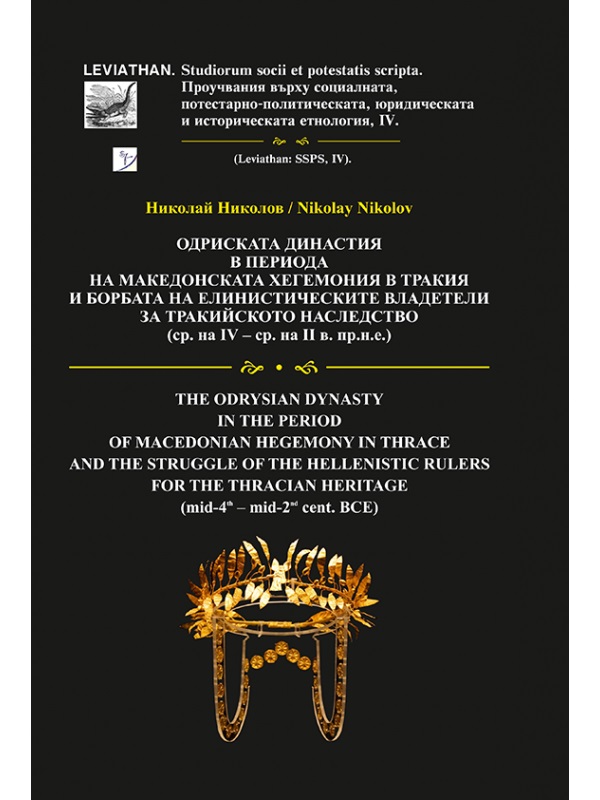
Nikolay Nikolov,The Odrysian Dynasty in the Period of Macedonian Hegemony in Thrace and the Struggle of the Hellenistic Rulers for the Thracian Heritage (mid-4th – mid-2nd cent. BCE) / Одриската династия в периода на македонската хегемония в Тракия и борбата на елинистическите владетели за тракийското наследство(LEVIATHAN. Studiorum socii et potestatis scripta. IV)Sofia 2025ISBN 978-619-7602-82-1448 S./pp., zahlr. S/W-Abb./num. b/w-figs., 28,5 x 20 cm; kartoniert/hardcoverbulgarisch mit englischer Zusammenfassung /bulgarian with english summaryThe object of the study is the Odrysian dynasty, and the subject is the processes that took place in it (including its historical development) in the period from the middle of the 4th to the middle of the 2nd century BCE. The main focus is placed on the state and development of the dynastic house of the Odrysians in the period of the Macedonian hegemony in Thrace and the subsequent era of aspirations toward the Thracian lands by the Hellenistic states – an era that ended with the beginning of the establishment of the military-political presence of the Roman Republic over the territory of the Balkan Peninsula. Table of contents Stefan YORDANOV. THE TERES’ DYNASTY IN DEFENSE OF THE POLITICAL INDEPENDENCE OF ITS DOMAINS. A NEW INVESTIGATION ON THE POLITICAL HISTORY OF ANCIENT THRACE LIST OF ABBREVIATIONS LIST OF ILLUSTRATIONS INTRODUCTION AIM, OBJECTIVES AND FRAMEWORK OF THE RESEARCH METHODOLOGY CHAPTER I. HISTORICAL SOURCES AND HISTORIOGRAPHY I. 1. HISTORICAL SOURCES I. 2. HISTORIOGRAPHY CHAPTER II. THE ODRYSIAN DYNASTY – POTESTARY-POLITICAL TRADITIONS II. 1. A THEORETICAL ANALYSIS OF THE PROCESS OF GENESIS OF THE RULER’S INSTITUTION II. 1. 1. The King-Priest – a Rudimentary Type of “Power” II. 1. 2. The Role of the Sex-Age Stratification in the Genesis of the Ruler’s Institution – Old vs. Young, or Peacetime Chiefs vs. Wartime Chiefs II. 1. 3. Relics of the Traditional System of the Sex-Age Organization in Antiquity and Ancient Thrace II. 2. POWER AND SUCCESSION – THE ODRYSIAN FRATRIARCHAL-PARADYNASTIC SYSTEM OF GOVERNMENT II. 2. 1. Principle of Succession II. 2. 2. Nature of Power and Separatist Tendencies II. 3. A GENERAL PRESENTATION OF THE DEVELOPMENT OF THE “EARLY” ODRYSIAN STATE AS A PARADIGM OF THE FRATRIARCHAL-PARADYNASTIC SYSTEM OF GOVERNMENT II. 3. 1. The Paradynastic Institution II. 3. 2. The Reign of Kotys I and the Uprisings of Adamas/Adamantus and Milthocytes – an Episodes from the Fratriarchal Struggles among the Odrysians II. 3. 3. The Partition of the Odrysian State – a Model of Formation of “Subsidiary” Odrysian State Formations CHAPTER III. THE MACEDONIAN HEGEMONY IN THRACE (356–323 BCE) III. 1. STAGES OF MILITARY-POLITICAL ESTABLISHMENT OF THE MACEDONIAN HEGEMONY OVER THE LANDS OF THE DIVIDED ODRYSIAN STATE (356–341 BCE) III. 1. 1. Territorial Core of the Odrysians and Geographical Dimensions of their Military-Political Influence III. 1. 2. Between Ketriporis and Amatocos – Initial Steps of Philip II in Thrace (356–352 BCE) III. 1. 3. The First Campaign of Philip II against Kersebleptes – Knowing the Enemy (352/351 BCE) III. 1. 4. The Second Campaign of Philip II againt Kersebleptes and the Peace of Philocrates – the Forerunners of the Macedonian Hegemony in Thrace (346 BCE) III. 1. 5. The Third Campaign of Philip II against Kersebleptes (342/341 BCE) – the Submission of Thrace (?) III. 2. CHARACTERISTICS OF THE MACEDONIAN HEGEMONY ACCORDING TO THE WRITTEN SOURCES ON THE CONQUESTS OF PHILIP II AND ALEXANDER III III. 2. 1. Main Patterns in the Policy of Conquest of Philip II – a Paradigm of Synthesis between the Macedonian’s Hegemony Ambitions and the Greeks’s Panhellenistic Dreams III. 2. 2. Main Patterns in the Policy of Conquest of Alexander III – Continuity and Evolution of the Philip’s Legacy III. 3. THE ODRYSIAN DYNASTY AND THE MACEDONIAN HEGEMONY IN THRACE (340–323 BCE) III. 3. 1. Presumed Odrysian Dynastic Centres after 341 BCE III. 3. 2. The Policy of Alexander III towards Thrace CHAPTER IV. THE STRUGGLE FOR THE THRACIAN HERITAGE (323–146 BCE) IV. 1. FROM PARADYNASTY TO DYNASTY – THE “SUBSIDIARY” ODRYSIAN AND POST-ODRYSIAN STATE FORMATIONS FROM THE END OF 4th TO THE END OF 3rd CENTURY BCE IV. 1. 1. Seuthes (III) and the Seuthopolian Dynasty IV. 1. 2. Spartokos, Skostokos (?) and the Dynastic House in Kabyle IV. 1. 3. Dromichaetes – the “Odrysian” Ruler of the Getae IV. 1. 4. Other Odrysian and post-Odrysian Dynastic Branches – Kotys (son of Raizdos), Kotys (father of Rhaskuporis), Sadala IV. 2. THRACE, THE ODRYSIANS AND LYSIMACHUS – THE DECLINE OF THE HEGEMONY OVER THRACE (323–281 BCE) IV. 2. 1. Lysimachus and the End of the Argeads (323–305/304 BCE) IV. 2. 2. Lysimachus the Basileus (305/304–281 BCE) – an Attempt to Establish a New Hegemony in Thrace (?) IV. 3. THE ASPIRATIONS FOR THE LYSIMACHUS’ LEGACY – THE “HELLENISTIC HEGEMONY” IN THRACE (281–221 BCE) IV. 3. 1. The Antigonid Dynasty – New Macedonian Ambitions towards Thrace IV. 3. 2. The Seleucid Dynasty – the Thracian Campaign of Antiochus II Teos IV. 3. 3. The Ptolemaic Dynasty – the Odrysian Diaspora in Egypt IV. 4. ROME AND THE ABOLITION OF THE HELLENISTIC STATUS QUO IN THRACE (221–146 BCE) IV. 4. 1. The Roman Republic and the Hellenistic Monarchies (221–188 BCE) – the Roman Dictates on Philip V and Antiochus III IV. 4. 2. Trends in the Expansion of the Roman Republic from the end of the 3rd and the beginning of the 2nd century BCE IV. 4. 3. Thrace on the Verge of Two Eras (188–146 BCE) – the Odrysian Dynastic Line of Seuthes, Kotys and Teres CONCLUSION APPENDICES I. THE “LATE” ODRYSIAN RULERS: HISTORICAL FIGURES OR HISTORIOGRAPHICAL MYTH II. TEREUS = TERES (?), OR BETWEEN MYTHOLOGY AND HISTORY – DID THE ODRYSIAN LEGENDARY GENEALOGY EXIST? III. RESPONSES TO REVIEWERS’ COMMENTS SUMMARY IN ENGLISH BIBLIOGRAPHY
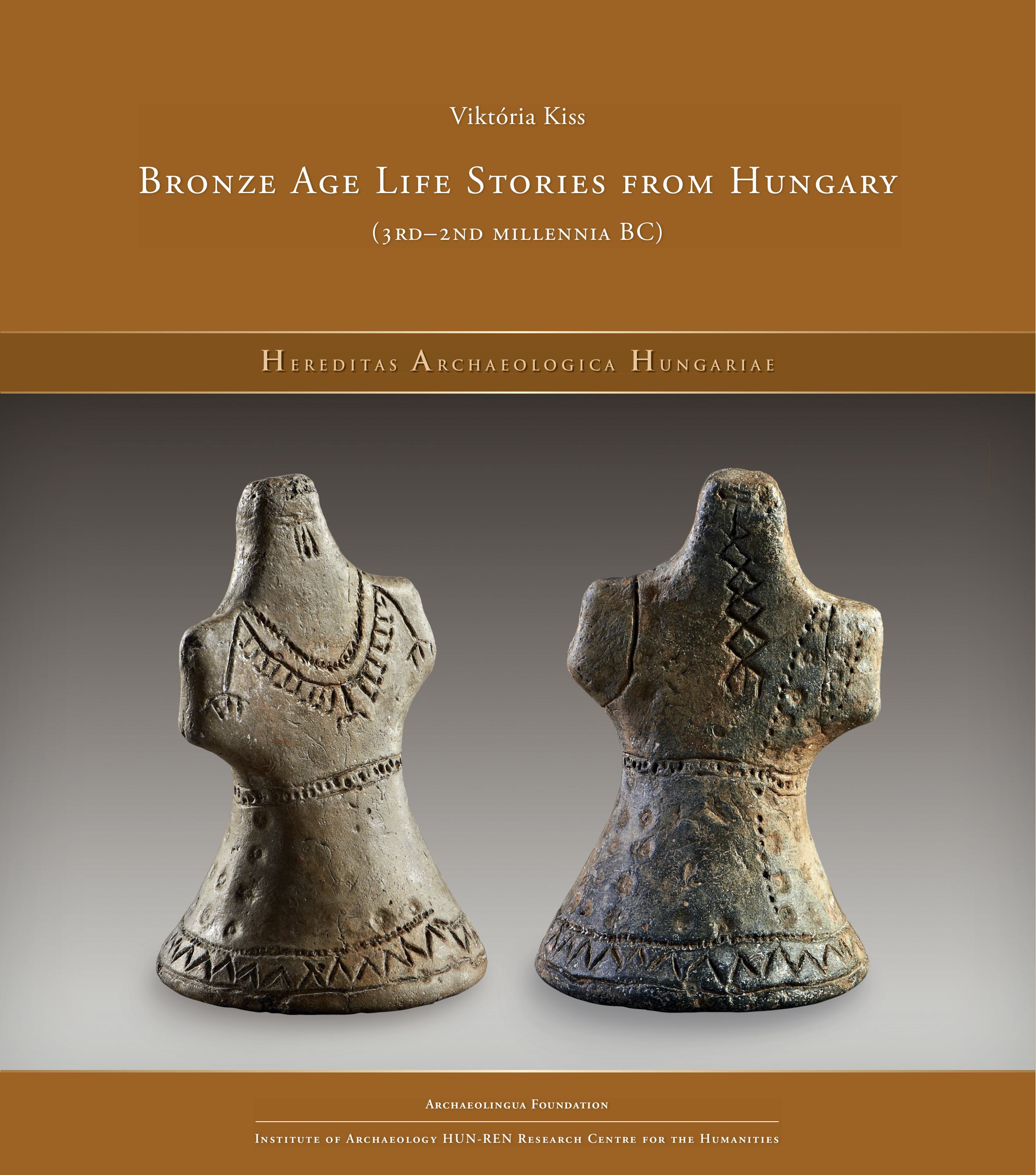
Víktoria Kiss, Bronze Age Life Stories from Hungary (3rd–2nd millennia BC)Budapest 2025ISBN 978-615-5766-79-4208 S./pp., zahlr. Farb- und S/W-Abb. / num. colour and b/w-figs., 24 x 21 cm; broschiert/softcover

Botond Rezi – Horia Ciugudean (eds.),The Bronze Age at the edge of the Carpathian basin : volume in honour of Carol Kacsó on the occasion of his 80th birthday / Epoca bronzului la fruntariile Bazinului carpatic : volum omagial în onoarea lui Carol Kacsó la împlinirea a 80 de aniCluj – Napoca 2025ISBN 978-606-020-925-6376 S./pp., zahlr. Farb- und S/W-Abb./num. colour and b/w-figs., 29,7 x 21 cm; kartoniert/hardcover

Ionel Cândea (ed.), The Thracians and Their Neighbours in Antiquity: Archaeology and History. Studies in Honor of Valeriu Sîrbu at his 70th AnniversaryBrăila 2020ISBN 978-606-654-403-0XXVIII + 562 S./pp., Farb- und S/W-Abb./colour and b/w-figs., 23 x 17 cm; kartoniert/hardcover

Nikola Tonkov, Integrated magnetic and electrical resistivity survey of archaeological sites / Комплексно магнитно и електросъпротивително проучване на археологически обекти (Excavations and Research / Разкопки и проучвания, vol. 52)Sofia 2024ISBN 978-619-245-479-1176 S./pp., zahlr. Farb- und S/W-Abb./num. colour and b/w-figs., 28,5 x 20 cm; kartoniert/hardcover Table of contents Предговор 1. ВЪВЕДЕНИЕ 2. МАГНИТОПРОУЧВАНЕ 2.1. Принципи 2.2. Видове магнитометри 2.3. Методика 2.3.1. Апаратура 2.3.2. Мрежа на измерване 2.3.3. Обработка на данните 2.3.4. Пречещи фактори (източници на смущения) 3. ЕЛЕКТРОСЪПРОТИВИТЕЛНО ПРОУЧВАНЕ 3.1. Принципи 3.2. Методика 3.2.1. Избор на електродна схема 3.2.2. Апаратура 3.2.3. Мрежа на измерване 3.2.4. Обработка на данните 3.2.5. Пречещите фактори 4. КОМПЛЕКСНО МАГНИТНО И ЕЛЕКТРОСЪПРОТИВИТЕЛНО ПРОУЧВАНЕ НА АРХЕОЛОГИЧЕСКИ ОБЕКТИ 4.1. Античен обект Скобелеве север 4.2. Античен обект Скобелево - Бозаджии 4.3. Античен обект Кермен изток 4.4. Античен обект Кермен север 4.5. Античен обект при с. Коньово 4.6. Античен обект Кермен запад 4.7. Светилище на нимфите и Афродита при с. Каснаково 4.8. Античен обект при с. Алдомировци 4.9. Никополис ад Иструм 4.10. Кабиле и Пистирос 4.11. Обекти от праисторията при с. Чокоба и гр. Върбица 4.12.Тракийска надгробна могила „Гармишка тумба" при гр. Черноморец 5. ЗАКЛЮЧЕНИЕ БИБЛИОГРАФИЯ SUMMARY Bulgarisch mit ausführlicher englischer ZusammenfassungBulgarian with an extended summary in English

Igor Borzić – Anamarija Eterović Borzić – Dinko Radić,Kopila. Grad mrtvih nad poljem Života / The city of the dead above the field of lifeSplit 2025ISBN 978-953-7633-53-0 96 S./pp., zahlr. Farbabb./num. colour figs., 27,5 x 21,5 cm; broschiert/softcover zweisprachig kroatisch - englisch / bilingual croatian - english An extraordinary collection of Hellenistic pottery has been discovered at the prehistoric necropolis of Kopila – vessels carefully placed alongside the deceased, always in the same positions, almost identical in shape and decoration. Guttoi. Skyphoi. Kantharoi. Repeated from grave to grave – like a ritual, like a vow, like a bridge. These vessels are not mere archaeological artefacts. They are objects of passage, soul guardians, silent witnesses to the belief that death is not the end. The pottery from Kopila speaks of an organised funerary system, of a community with clearly defined rituals and spiritual beliefs that transcend time and space. In its silence echoes a question for today’s observer: if we could carry something with us – one object, one thought, one value – what would it be?
![Kliškić, Damir : Dugiš, otok u rijeci vremena [= Dugiš, an island in the river of time] Kliškić, Damir : Dugiš, otok u rijeci vremena [= Dugiš, an island in the river of time]](https://phoibos.at/media/bb/99/6d/1754392213/978-953-7633-42-4.jpg?ts=1754392213)
Damir Kliškić,Dugiš, otok u rijeci vremena [= Dugiš, an island in the river of time. Life in Prehistory – a pile dwelling near Otok on the Cetina]Split 2024ISBN 978-953-7633-42-4 190 S./pp., zahlr. Farbabb./num. colour figs., 27 x 21 cm; broschiert/softcoverDie prähistorische Hüttensiedlung auf Dugiš in Otok bei Sinj wurde 1955–1956 vom Archäologischen Museum in Split untersucht. Es ist die einzige Hüttensiedlung in ganz Dalmatien, die bisher untersucht wurde. Dem gesammelten archäologischen Material zufolge weist dieser Standort eine Kontinuität des Lebens von der mittleren Bronzezeit (1700–1300 v. Chr.) bis in die Antike auf, wie Münzbeispiele aus dem 1.–5. Jahrhundert n. Chr. belegen. Das Hauptziel dieser Ausstellung ist es, der Öffentlichkeit eine sehr spezifische und bisher wenig bekannte Siedlungsform aus prähistorischer Zeit vorzustellen, nämlich die Hüttensiedlung, und zwar anhand eines Teils des ursprünglichen materiellen Erbes von der mittleren Bronzezeit bis zur frühen Eisenzeit. Die Ausstellung präsentiert zahlreiche Objekte aus Metall, Keramik, Knochen und Stein, die an verschiedene wirtschaftliche und soziale Aktivitäten im genannten Zeitraum erinnern. Neben den Originalen zeigt die Ausstellung 18 Kopien von Gefäßen, die nach 18 originalen Keramikobjekten von diesem Standort angefertigt wurden.

Emilio Marin, Greek Personal Names in Dalmatia. A Lexicon A Contribution to the Onomastics of the Hellenistic Eastern Adriatic Coast and the Province of the Roman Empire, 4th century BC – 7th century AD(Opera Varia. Musei Archaeologici Zagrabensis V) (Opera Varia. Arheološkog muzeja u Zagrebu V)(Opera Varia of the Archaeological Museum of Zagreb V)Zagreb 2023ISBN 978-953-8143-66-3 152 S./pp., zahlr. Farb- und S/W-Abb./num. colour and b/w-figs., 30 x 23 cm; broschiert/softcover
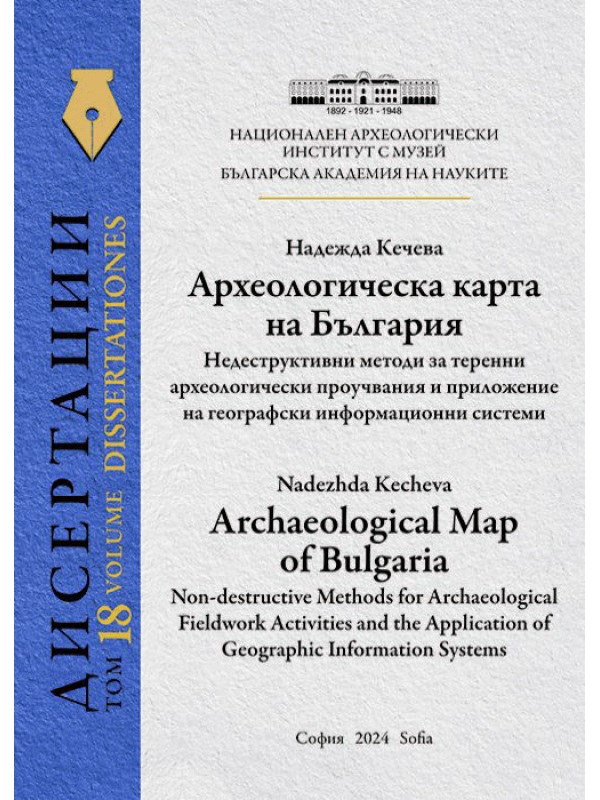
Nadezhda Kecheva, Archaeological Map of Bulgaria. Non-Destructive Methods for Archaeological Fieldwork Activities and the Application of Geographic Information Systems(Dissertationes, volume 18) / Археологическа карта на България. Недеструктивни методи за теренни археологически проучвания и приложение на географски информационни системи (Дисертации, Том 18)Sofia 2024ISBN 978-619-245-482-1XXVIII + 436 S./pp., S/W-Abb./b/w-figs., Tafeln/plates, 28,5 x 20 cm; kartoniert/hardcoverbulgarisch mit ausführlicher Zusammenfassung in englischbulgarian with extended summary in english This monograph is the publication of the dissertation defended in May 2018 at the Department of Classical Archaeology at the National Archaeological Institute with Museum at the Bulgarian Academy of Sciences (NAIM–BAS). During the period 2018–2024 the study was partially updated.The research covers the following topics: 1) archaeological survey: development of theory and methods; 2) application of remote sensing and geophysical surveys as well as geographic information systems in archaeology; 3) development of the "Archaeological Map of Bulgaria" and surveys in Bulgaria; conceptual schemes and reference models at European and global scale; 4) creation, characteristics and future development of the Geographic Information System "Archaeological Map of Bulgaria". An appendix presents an English-Bulgarian glossary of terms used in the text, together with their definitions.
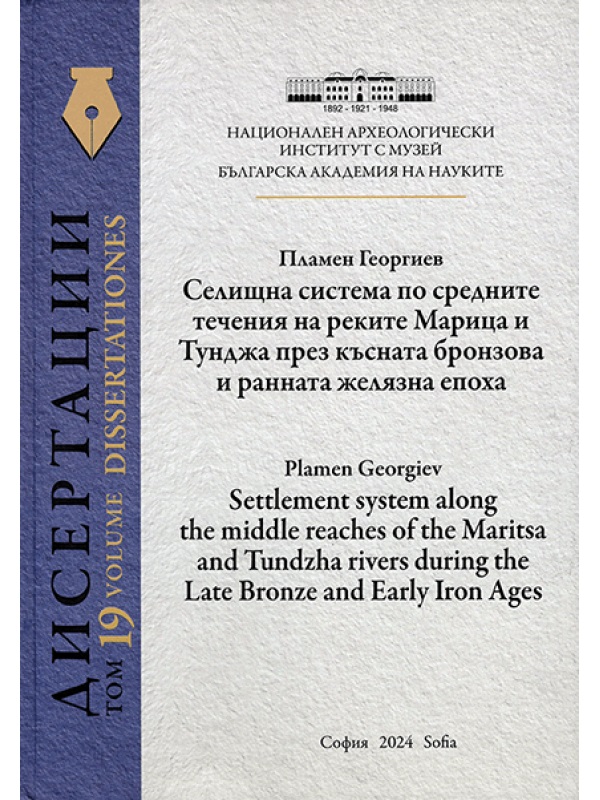
Plamen Georgiev, Settlement system along the middle reaches of the Maritsa and Tundzha rivers during the Late Bronze and Early Iron Ages(Dissertationes, volume 19) / Селищна система по средните течения на реките Марица и Тунджа през късната бронзова и ранната желязна епоха(Дисертации, Том 19)Sofia 2024ISBN 978-619-245-509-5240 S./pp., zahlr. Farb- und S/W-Abb. / num. colour and b/w-figs., 28,5 x 20 cm; kartoniert/hardcoverbulgarisch mit ausführlicher Zusammenfassung in englischbulgarian with extended summary in english Introduction1. History of research into the Late Bronze and Early Iron Ages in Bulgarian archaeology2. Source base: Current state and general problems3. Topography and landscape features of the Late Bronze and Early Iron Age settlement system along the middle cources of the Maritsa and Tundzha rivers4. Climate and economy during the Late Bronze and Early Iron Age5. Spatial analysis of the settlement systemConclusionBibliographyCatalog

Zheni Vasileva,Jewellery production in Thrace and the Aegean during the 3rd millennium BC(Dissertationes, volume 20) /Ювелирно производство в Тракия и Егея през III хилядолетие пр. Хр.(Дисертации, Том 20)Sofia 2025ISBN 978-619-245-533-0592 S./pp., zahlr. Farb- und S/W-Abb./num. colour and b/w-figs., 29,7 x 21 cm; kartoniert/hardcoverenglisch mit ausführlicher Zusammenfassung in bulgarischenglish with extended summary in bulgarian The main text includes an introduction, six chapters, a conclusion, a bibliography, and a summary in Bulgarian. The study features a catalog of published materials from the Aegean, as well as both published and unpublished materials from Thrace. The first chapter examines the jewellery in its context, while the next four chapters present a typology of Early Bronze Age ornaments. The sixth chapter explores the jewellery centers of the 3rd millennium BC. The conclusion summarizes the key findings of the research, focusing on one of the most important topics: Thrace’s place in the world of jewellery production during the 3rd millennium BC. Table of contentsPrefaceIntroductionI. Third Millenium BC Jewellery and its Context1. Thrace2. Mainland Greece3. The Ionian Islands4. The Aegean Islands5. The Northern Aegean6. West Coastal Anatolia7. The Cycladic Islands8. Minoan CreteII. Head ornaments1. Diadems2. Hair rings3. EarringsIII. Neck Ornaments1. Torcs2. Beads3. SeparatorsIV. Hand / Wrist Ornaments1. Bracelets2. Finger-ringsV Dress Accessories1. Pins2. Appliques3. Buttons4. Pendants5. Loops6. ChainsVI. Third Milleniu BC Jewellery Production Centers1. West Coastal Anatolia2. The Cycladic Islands3. Minoan Crete4. Continental Greece5. Thrace Conclusion. The Influence of Jewellery in Thrace and the AegeanCatalogueBibliographyPlatesMaps

Desislava Takorova,The Early Neolithic Culture in the Struma River Valley and Sofia Plain in the Context of its Contacts with Anatolia(Dissertationes, volume 21) /Раннонеолитната култура в долината на Струма и Софийското поле в контекста на връзките й с Анатолия(Дисертации, Том 21)Sofia 2025ISBN 978-619-245-535-4292 S./pp., S/W-Abb./b/w-figs., Tafeln/plates, 29,7 x 21 cm; kartoniert/hardcoverbulgarisch mit ausführlicher Zusammenfassung in englischbulgarian with extended summary in english

Maria Alexandrescu Vianu, Une cité antique à travers ses sculptures. La sculpture en pierre à Tomis à l'époque du Principat : (Ier-IIIe siècles)(Bibliothèque de l'Institut d'études sud-est européennes ; 22)Brăila 2022ISBN 978-606-654-492-4300 S./pp., 92 Farb- und S/W-Taf., S/W-Abb. / 92 colour and b/w-pls., b/w-figs., 23 x 17 cm; kartoniert/hardcover
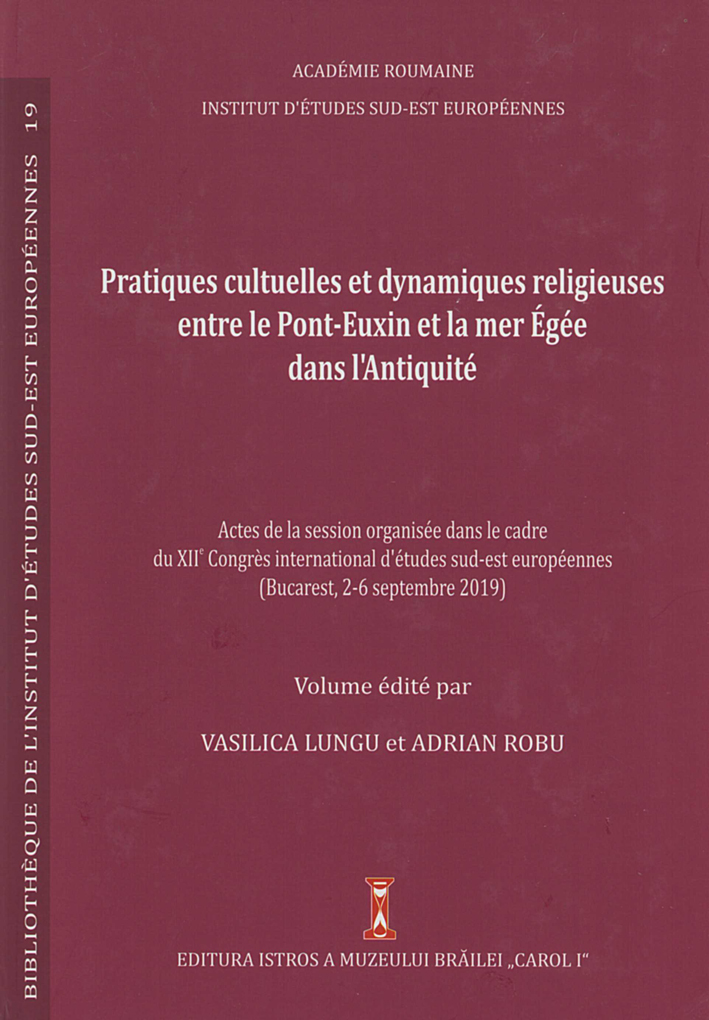
Vasilica Lungu – Adrian Robu (éds.), Pratiques cultuelles et dynamiques religieuses entre le Pont-Euxin et la mer Égée dans l'Antiquité.Actes de la session organisée dans le cadre du XIIe Congrès international d'études sud-est européennes (Bucarest, 2-6 septembre 2019)(Bibliothèque de l'Institut d'études sud-est européennes ; 19)Brăila 2022ISBN 978-606-654-496-2326 S./pp., zahlr. Farb- und S/W-Abb. / num. colour and b/w-figs., 23 x 17 cm; kartoniert/hardcover

Miljenko Jurković – Ivan Basić – Ivan Josipović, Fortunatus Ligo. Festschrift on the occasion of Ante Milosevic’s 70th birthday /Zbornik povodom sedamdesetog rođendana Ante Miloševića(Dissertationes et Monographiae, vol. 20)Split – Zadar – Zagreb – Motovun 2024ISBN 978-953-8250-40-8ISBN 978-953-331-521-8ISBN 978-953-352-118-3576 S./pp., zahlr. Farb- und S/W-Abb./num. colour and b/w-figs., 28 x 20 cm; broschiert/softcover
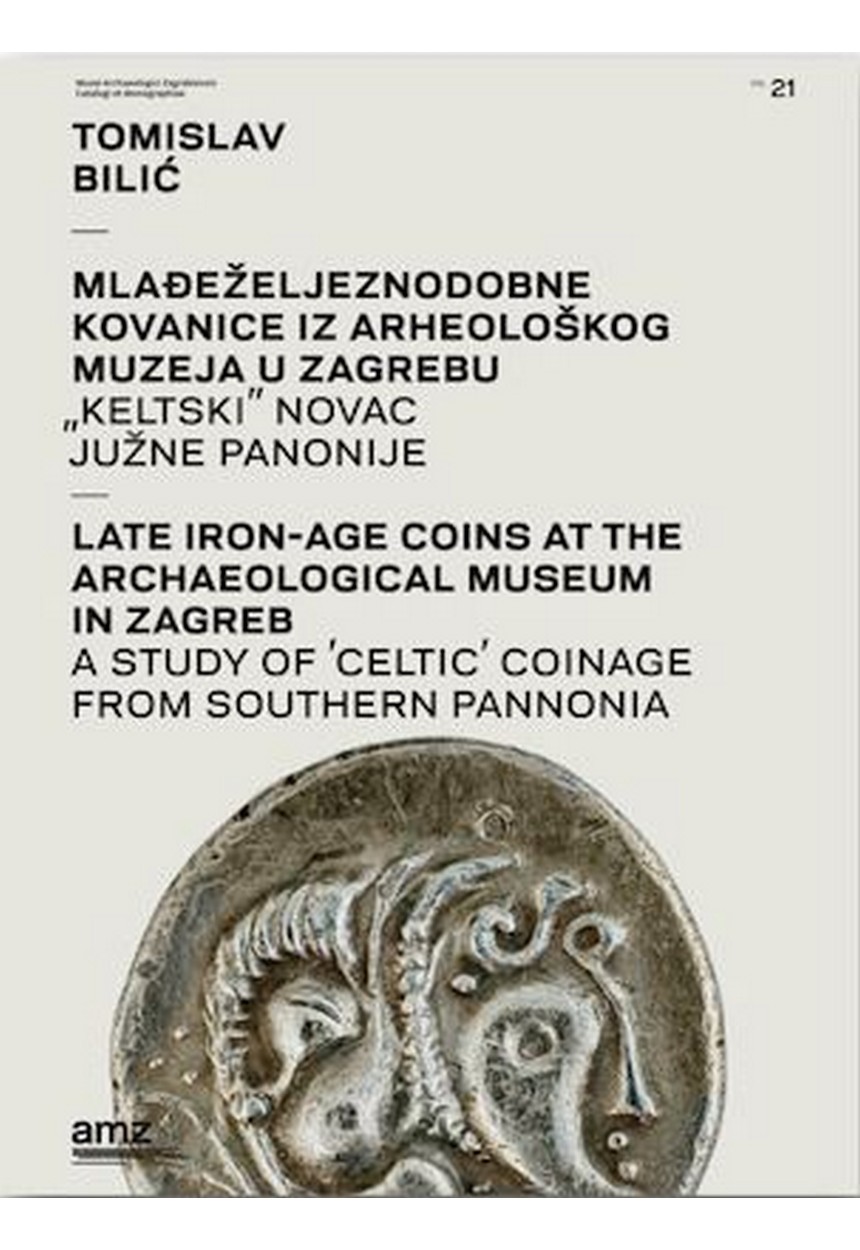
Tomislav Bilić,Late Iron-Age Coins at the Archaeological Museum in Zagreb. A study of the 'Celtic' Coinage from Southern Pannonia / Mlađeželjeznodobne kovanice iz Arheološkog muzeja u Zagrebu. „Keltski“ novac južne Panonije(Musei Archaeologici Zagrabiensis. Catalogi et Monographiae / Arheološkog muzeja u Zagrebu. Katalozi i monografije / Archaeological Museum in Zagreb. Catalogues and Monographs volumen / svezak / volume XXI)Zagreb 2024ISBN 978-953-8143-61-8ISBN 978-953-6335-26-8355 S./pp., zahlr. Farb- u. SW-Abb./num. colour and b/w-figs., 29,7 x 23 cm; kartoniert/hardcoverzweisprachig kroatisch - englischbilingual croatian - english
